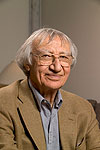Muzaffer Atac, 1931-2010
 |
|
Muzaffer Atac
|
From Chicago Tribune, Dec. 17, 2010
Physicist was among the founding scientists at Fermilab
As one of the founding scientists at Fermi National Accelerator Laboratory, the national physics lab near Batavia, Muzaffer Atac spent more than four decades working with detectors, which physicists use to record results and understand processes occurring deep inside the building blocks of matter.
The longtime head of Fermilab's detector development group, Dr. Atac also took great pride in education, working simultaneously in the 1980s as a physics professor at the University of California at Los Angeles and at the University of Texas at Dallas. And he helped to create detectors for demonstration purposes for Fermilab's education program, which teaches high-energy physics to junior high and high school students.
"He was just an all-around good guy," said Bruce Chrisman, Fermilab's chief operating officer, who was a graduate school classmate of Dr. Atac's in the 1960s at the University of Illinois. "He was very hardworking and was a solid citizen in the physics community."
A resident of Wheaton for almost 40 years, Dr. Atac, 79, died Tuesday, Dec. 7, at his home of cardiac arrest, said his wife of 52 years, Ayfer.
Born in Kemaliye, a small mountain village in eastern Turkey, Dr. Atac attended high school in Turkey's capital, Ankara, and went on to earn an undergraduate degree from the University of Ankara. He met his future wife in Turkey, and they wed in 1958.
Read more |